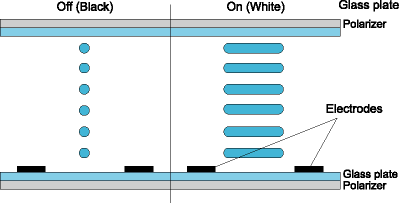TFT Guide - Part 2 - Viewing Angle Technologies
IPS (In-Plane Switching Or Super-TFT)
Figure 2: When a voltage is applied, the molecules are aligned parallel to the substrate.
IPS or 'In-Plane Switching' was originally developed by Hitachi, however NEC and Nokia now also produce displays that use this technology.
The difference to the twisted nematic displays (TN or TN+Film) is that the molecules of the liquid crystal are aligned parallel to the substrate.
Excellent viewing angles up to 170 degrees, such as are known from cathode ray tubes, are attained using IPS or Super-TFT technology. However, the technology also has a disadvantage: due to the parallel alignment of the liquid crystals, the electrodes may not be located on both glass surfaces as with twisted nematic displays. Instead, they must be implemented in a comb-like style on the lower glass surface. This ultimately leads to a reduction of contrast and therefore a stronger backlight is required in order to raise the brightness to the required level again. The response time and contrast are hardly improved in comparison with conventional TFT's.
Get Tom's Hardware's best news and in-depth reviews, straight to your inbox.
Current page: IPS (In-Plane Switching Or Super-TFT)
Prev Page TN+Film Next Page MVA (Multi-Domain Vertical Alignment)